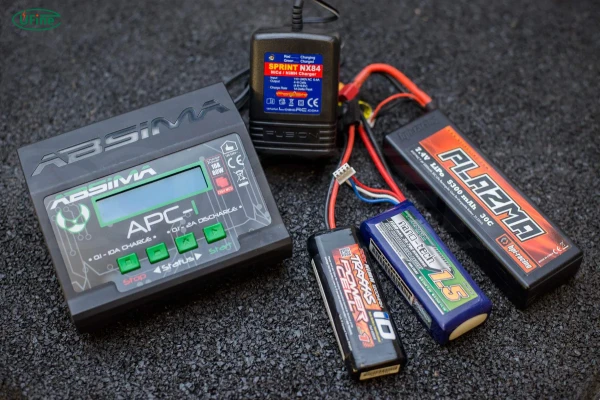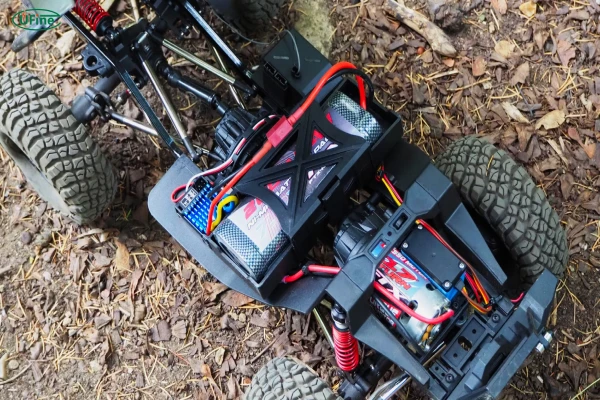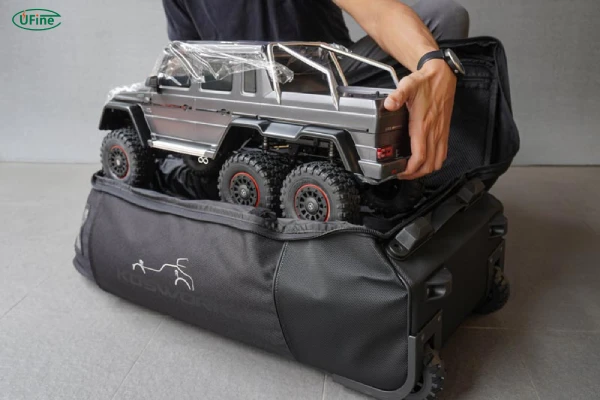If you’ve ever pushed your RC buggy to its limits, you already know that the battery isn’t just another component—it’s the heart of your vehicle. A high-quality rc buggy battery can mean the difference between a quick spin around the driveway and a full-throttle, adrenaline-pumping race across dirt trails.
But here’s the truth: with so many battery types, capacities, voltages, and charging systems, it’s easy to feel overwhelmed. This guide is here to clear up the confusion, help you make informed choices, and show you how to squeeze every drop of performance from your battery pack.
Part 1. RC buggy battery types

Let’s start with the basics. Not all RC buggy batteries are made the same. In fact, choosing the right one depends heavily on your goals—are you in it for casual fun, competitive racing, or just long-lasting play?
NiMH (Nickel-Metal Hydride)
- Pros: Affordable, safe, and fairly easy to maintain.
- Cons: Heavier and less efficient than other types.
- Best for: Beginners or casual drivers who prioritize simplicity.
NiMH batteries have been around for a while. They’re forgiving if you make a few charging mistakes and don’t require a special charging routine. However, they lack the punch and longevity that more advanced drivers crave.
LiPo (Lithium Polymer)
- Pros: Lightweight, powerful, fast-charging, and high energy density.
- Cons: Requires careful handling, storage, and charging.
- Best for: Hobbyists, racers, and anyone chasing top-tier performance.
A LiPo rc buggy battery pack is the gold standard in the RC world. These packs can deliver a ton of power in a short time, which means better acceleration, speed, and fun. But they also demand respect—charge or store them wrong, and you’re risking fire or failure.
Li-Ion (Lithium-Ion)
- Pros: Long lifespan, stable discharge.
- Cons: Lower peak power than LiPo.
- Best for: Long-distance driving where consistent performance is more important than bursts of speed.
While not as commonly used in RC buggies as LiPo or NiMH, Li-Ion is slowly gaining ground for endurance drivers.
NiMH Battery vs Li-Ion Battery vs NiCad Battery: How are they different?
Custom Lithium Batteries from Ufine Battery
If your RC buggy demands something more tailored—such as unique dimensions, voltages, or ultra-lightweight construction—Ufine Battery offers custom lithium battery solutions designed to meet exact performance needs.
Ufine is a trusted Chinese lithium battery manufacturer specializing in:
- Lithium polymer batteries (LiPo)
- LiFePO4 batteries
- 18650 and cylindrical batteries
- Ultra-thin, high-rate, and high-temperature lithium batteries
We offer custom solutions for hobbyists, professionals, and RC manufacturers alike. Whether you need extreme discharge rates for racing or compact sizes for tight buggy chassis, Ufine Battery can design the perfect battery for you.
👉 Looking for a battery built specifically for your buggy? Contact Ufine Battery to request a custom quote.
Part 2. Which RC buggy battery is better?
There’s no one-size-fits-all answer to this question. The best rc buggy battery for you depends on several factors, including your driving style, budget, and how much effort you’re willing to put into care and maintenance.
Consider These Questions:
- Do you want explosive power and speed?
- Do you prioritize safety and ease of use?
- Will you be racing or bashing around the backyard?
If speed and performance are your top priorities, LiPo is the obvious winner. But if you’re just getting started or want a worry-free experience, NiMH might suit you better. Many drivers eventually upgrade from NiMH to LiPo as their skills and needs grow.
Part 3. What makes a LiPo RC buggy battery pack do popular?
LiPo batteries are beloved in the RC world for good reason. Here’s a breakdown of what makes them special:
Configuration and Cells
LiPo packs come in different configurations:
- 2S (7.4V)
- 3S (11.1V)
- 4S (14.8V)
The “S” refers to how many cells are connected in series. More cells = more voltage = more speed. But you have to ensure your ESC (Electronic Speed Controller) and motor can handle it.
C Rating – What Is It?
The C rating tells you how fast a battery can safely discharge its energy. A higher C rating means more power delivery to your motor.
Example: A 5000mAh battery with a 40C rating can theoretically provide up to 200A of current.
(5000 ÷ 1000) × 40 = 200A
This is crucial for racers or those with high-demand brushless systems.
Part 4. How much battery capacity do you need?
Here’s where many drivers get it wrong. Capacity, measured in mAh (milliamp hours), determines how long your buggy can run before the battery needs recharging.
Calculating Your Battery Needs
To figure out how much capacity you need, ask yourself:
- How many amps does your buggy typically draw?
- What’s your desired run time?
Example Calculation:
If your buggy pulls 20A continuously and you want to run for 15 minutes (0.25 hours):
20A × 0.25h = 5Ah → You’ll need at least a 5000mAh LiPo battery
Just keep in mind: more capacity also means more weight. That could affect handling and performance. It’s all about balance.
Ufine Battery can customize batteries with precise capacity and size to help you optimize both performance and run time. Whether you’re chasing longer sessions or a specific weight-to-power ratio, they can manufacture what you need.
Part 5. Is an RC buggy bag worth it?
You might not think much about a rc buggy bag—until your expensive LiPo gets crushed under a pile of tools. Or worse, starts puffing from overheating during transport.
A Good Bag Should Offer:
- Fireproof compartments for LiPo storage
- Padded protection against bumps and drops
- Organization for chargers, tools, and spare parts
Peace of mind? Yeah, that’s worth the $20–$50 investment any day.
Part 6. What charger should you use for RC buggy batteries?
The charger you choose matters—a lot. Especially for LiPo batteries. Using the wrong charger or charging incorrectly is one of the fastest ways to damage your rc buggy battery (or worse, start a fire).
Must-Have Features for a Good RC Charger:
- Balance charging (for LiPo cells)
- Adjustable current and voltage
- Safety shutoffs and overcharge protection
- Compatibility with multiple battery types (NiMH, LiPo, Li-Ion)
Brands like ISDT, Hitec, and SkyRC are solid options.
Part 7. RC buggy battery maintenance & care tips
Taking good care of your battery is just as important as choosing the right one. It saves you money, prevents safety hazards, and keeps your buggy performing like a champ.
Top Battery Care Tips:
- Never over-discharge LiPos. Stop using them if voltage drops below 3.2V per cell.
- Store LiPos at 3.7–3.8V per cell. Not full. Not empty.
- Always use a fireproof charging bag.
- Inspect your batteries regularly for puffing, cracks, or corrosion.
- Keep them cool—never leave them in a hot car or direct sunlight.
A well-maintained battery can easily last over 200–300 cycles.
Part 8. FAQs
Can I use a 3S battery in a buggy made for 2S?
No. Always follow the voltage recommendations for your ESC and motor to avoid damage.
How do I know when a LiPo battery is bad?
Signs include puffing, low capacity, poor balance between cells, and abnormal heat during use.
Can I revive a dead LiPo?
Sometimes, but it’s risky. If a LiPo drops below 3.0V per cell, it’s usually time to retire it.
Should I always fully charge my battery?
Only before use. Never store a LiPo fully charged for more than a few days.
Related Tags:
More Articles

Paper Battery vs. Flexible Battery: What’s the Difference and Which Is Better?
Paper vs. flexible batteries: learn the key differences, benefits, and which power source fits best for wearables, sensors, and smart tech.
What to Know Before Buying a Tiny LiPo Battery for Your Project
Tiny LiPo batteries are powerful and compact. Learn how to choose the right one for your project with specs, safety, and charging tips.
Bloated LiPo Battery: Will It Explode?
Will a bloated LiPo battery explode? Discover the causes, risks, safety steps, and expert tips to avoid disaster and protect your gear. Must-read safety guide!
12V 100Ah Lithium Ion Battery Price: Full Guide
Learn about 12V 100Ah lithium-ion battery price, from cost ranges to best brands, hidden fees, and how to get the best deal. A must-read for smart buyers!
Resistance and Conductivity: What It Means for Your Lithium Batteries
Resistance and conductivity impact lithium battery performance, lifespan, and safety—learn how they work and why they matter.






